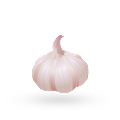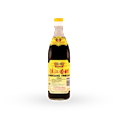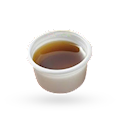This traditional Chinese seasoning mix is said to have originated in Sichuan cuisine, which is known for spiciness and bold flavors, but has since spread to other regions as well. The word yuxiang also refers to the sauce in which the meat or vegetables were cooked. Yúxiāng literally translates to fish fragrance, although it contains no seafood and is not commonly used in seafood dishes, but rather to create a flavor base for vegetarian recipes and various dishes containing beef, pork, or chicken.
The mix typically consists of finely minced pickled chili called pao la jiao, white scallion, ginger, and garlic; in more or less equal amounts. To create the sauce, on top of the basic mixture, cooking with yúxiāng almost always includes the use of sugar, salt, chili peppers, soy sauce or vinegar and doubanjiang - a spicy fermented broad bean, soybean, and rice paste popularly known as the soul of Sichuan cuisine.
MAIN INGREDIENTS
Mala is a brothy, spicy sauce consisting of Sichuan peppercorns, chili peppers, oil, and a handful of various spices. In Chinese gastronomy, it is considered as one of the most popular sauces with many regional varieties. The sauce is so spicy that it is even implicated in its name, the term málà literally meaning numbing and spicy, caused by the Sichuan peppercorns.
Although the origins of the sauce are still unclear, the most popular theory suggests that it was invented in Sichuan in the 19th and 20th century, when it was full of pier workers who were regularly eating cheap foods such as beef stomach, kidney, and solidified blood.
Serve with
Sometimes referred to as caviar of the East, XO sauce is a popular sauce originating from Hong Kong, consisting of boiled dried scallops, dried shrimp, dried ham, garlic, onions, and chili peppers. XO refers to extra old cognac, even though the sauce doesn't contain a drop of it.
Because cognac is considered chic and is a status symbol in Hong Kong, the sauce is also packaged in a similar-looking box, which is very clever marketing, if nothing else. However, XO sauce is extremely flavorful and full of umami, showing up even in restaurants across North America.
Hoisin sauce is a common ingredient in Asian cuisine, used for glazing and flavoring a wide variety of grilled or stir-fry meat and seafood dishes. It can even be used for preparing marinades, but also as a dipping sauce for spring rolls, egg rolls, grilled tofu, and other appetizers, or as a base for preparing more complex sauces.
With a unique blend of flavors, the aromatic hoisin sauce is usually made with starches such as sweet potato, wheat or rice, fermented soybeans, sesame paste, garlic, rice vinegar, red chili peppers, and brown sugar. With its distinctive, well-balanced flavor of salty, sweet, and spicy notes, hoisin sauce adds a boost of umami to many classic Chinese dishes such as Peking duck and moo shu pork.
Serve with
MAIN INGREDIENTS
Shacha sauce is a popular Chinese condiment made with garlic, chili, brill fish, dried shrimp, shallots, and soybean oil. The ingredients are mashed, then combined, and the versatile sauce can be used in a number of ways: as a seasoning for stir-fries, as a base in different soups, as a meat rub, or as a key ingredient in dipping sauces.
The flavor of shacha sauce is often described as savory and slightly spicy, and it is most commonly used with a variety of beef dishes.
MAIN INGREDIENTS
Tsukejiru is a traditional dipping sauce for cold noodles. The sauce consists of soy sauce, sugar, dashi, mirin, and bonito flakes. Once cooked, the dipping sauce is strained through a sieve lined with a cotton cloth and it's then left to chill.
In Japan, it's especially popular to serve tsukejiru with cold hiyamugi noodles on a hot summer day.
MAIN INGREDIENTS
Sweet and sour sauce is usually associated with the authentic Chinese combination of rice vinegar and sugar. The probable origin of this sweet and sour mixture is the Chinese province of Hunan, where it was originally used as a condiment or a sauce for fish, meat, and vegetables.
Some theories claim that the Chinese province of Guangdong was the place where this traditional sauce first appeared, but it is also possible that both sauces were developed independently at the same time in different provinces. The primary form had a pale yellow color, it was usually uncooked and served on the side as a dipping sauce.
Serve with
Plum sauce is a flavorful condiment consisting of sweet plums, vinegar, ginger, chili, garlic, sugar, and salt. It has Chinese origins and is an often-seen condiment of choice in numerous Chinese restaurants. The sauce can be used as a dip for a variety of dishes such as roast duck, spring rolls, and noodles, or it can be brushed on poultry or ribs before grilling.
Additionally, other fruits such as apricots or prunes can be added to the sauce in order to thicken it.
Serve with
MAIN INGREDIENTS
Siu haau is a popular type of thick, savory, and slightly spicy barbecue sauce that is primarily used in Chinese and Cantonese cuisine. It is not used as a flavoring after the food is done, like some other sauces, but during the barbecue process, while the meat is still cooking.
The sauce usually consists of a combination of soy, oyster, and hoisin sauce, sugar, garlic, honey, pepper, and salt.
Guaiwei is a unique Sichuan blend of spices that is commonly used in the preparation of sauces or as a seasoning for various seafood and meat dishes. Its name is literally translated to strange or exotic taste and is extremely prized in Sichuan cuisine, although it is rare to find it outside of the region.
Essentially, it is a combination of mala seasoning and yuxiang sauce, with added sugar, sesame seeds or oil, rice vinegar, soy sauce, and Sichuan peppercorns, resulting in a complex layering of piquant, salty, sweet, and sour flavors.
TasteAtlas food rankings are based on the ratings of the TasteAtlas audience, with a series of mechanisms that recognize real users and that ignore bot, nationalist or local patriotic ratings, and give additional value to the ratings of users that the system recognizes as knowledgeable. TasteAtlas Rankings should not be seen as the final global conclusion about food. Their purpose is to promote excellent local foods, instill pride in traditional dishes, and arouse curiosity about dishes you haven’t tried.
















